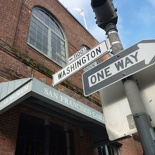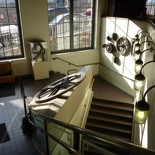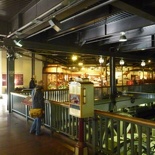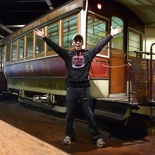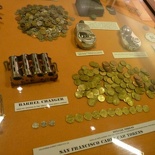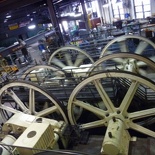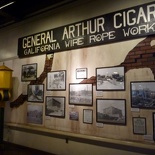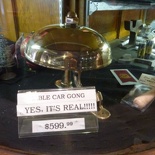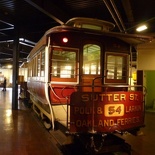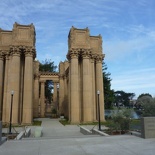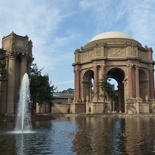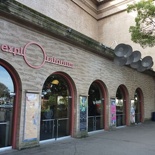Cable car museum
The San Francisco cable car system is the world’s last permanently operational manually operated cable car system dating back since the 1800s. The Cable Car Museum is a free museum showcasing this very history which the city is famous for. Situated along Washington Street at 1201 Mason Street just off Chinatown in the Nob Hill neighborhood of San Francisco. Run and managed by the Friends of the Cable Car Museum, the establishment is a working museum, with the museum sharing part of the complex housing the cable car power house.
Housed in the museum section are various historical and explanatory exhibits of the currently active San Francisco cable car system. The top deck of the museum is home to various smaller exhibits and old historical cable cars displays, including old carriages and several examples of interestingly designed old cable cars which look like covered train carriages. San Francisco’s cable car system had came through many years and numerous companies which operate them, each with their own unique cable car designs to boot too. The cable cars displayed includes the Sutter Street Railway which is essentially a grip car No. 46 and trailer No. 54 dating from the 1870s Clay Street Hill Railroad. Also kept here is Grip car 8 which is the only surviving car from the first cable car company.
The museum overlooks the “working areas” of the museum, which includes a workshop, drive wheels, maintenance and storage bay. The museum is essentially a “power house” which is not a power station in any way but is the heart of the cable car system by providing power- not through electrical power but by high speed cable drawing, which gives the cars the unique name “cable cars”.
Well, in fact, most of the museum’s floor area is the power house and dominates most of the building, with the museum only taking a small portion of the building. The large drive wheels which spin the cables can be seen from the museum itself and is part of the city’s subterranean cable network laid out in 1873. The power house area is a live and active car depot, and is not accessible to the public, but you can get vantage views of the work area, workshop and heavy machinery at work from the two overlooking galleries where the balcony where the museum reside.
I got to ride the cable car more than 15 years ago back in San Francisco as a kid, but never quite understood how it works without engines or even overhead electrical cables found on most of the mini transport buses. While most people will relate cable cars to cabs suspended by overhead cables as seen serving alpine ski slopes, the cables actually run underground through a very intricate and well laid pulley system. which drives the cables, and the car depot. Descending to the basement of the museum from the entrance will allow you to view the large cavern where the haulage cables are routed out to the street below the junction of Washington and Mason streets.
You can easily pop by the museum when you are around the Chinatown area and spend half an hour or so at the exhibits and museum store. Donations to the Friends of the Cable car museum are appreciated or you can simply make purchases from the museums too.
Palace of fine arts
Not too far off in the Marina District of San Francisco is a monumental structure originally constructed for the 1915 Panama-Pacific Exposition to showcase works of art presented then. This structure residing there now is known as The Palace of Fine Arts.
The palace is one of only a few surviving structures from the Exposition, still situated on its original site. Flaunted by the facade of the palace is a very nicely laid garden and lagoon, complete with it’s very own fountain to boot. No wonder it remains as a popular attraction and photographic sight for tourists and locals alike. It is also a favorite location for weddings and wedding party photographs for couples throughout the San Francisco Bay Area. In fact, the building is so iconic here that a miniature replica of it was built in Disney’s California Adventure.
Exploratorium science museum
Not too far off from the palace is The Exploratorium. It is an informal education center and museum with over 400 participatory exhibits, most of them remarkably made on-site in the museum itself well that mixes science and art. Founded in 1969 by physicist and educator Frank Oppenheimer, the place treats you to a variety of sensory experiences within the museum grounds itself. Bringing the exhibits to you in a variety of ways through physical displays, webcasts, websites and events, allowing an alternative and interactive way to explore and understand the world around you. In all it is pretty much a place for family and kids alike.
Notably, the museum received the National Science Board 2011 Public Service Science Award for its contributions to public understanding of science and engineering in 2011 and is regarded as one of the most prestigious national honors in science given to an organization.
Next up, up the Twin peaks and Castro.
- Chilling out in the city of San Francisco (Pier 39, Fisherman’s Wharf) (Photos: City Album)
- San Francisco Cable Car Museum, Palace of fine arts and Exploratorium
- Up the Twin peaks and the Castro district, San Francisco (Photos: Twin Peaks & Castro)
- Golden Gate Bridge and Fort Point (Photos: Golden Gate Bayside)
- Golden Gate Park and Deyoung Museum (Photos: Golden Gate Park & De Young)
- Legion of Honor Museum (Photos: Legion of Honor Album)
- On the Alcatraz (The Rock) (Photos: Alcatraz Album)

